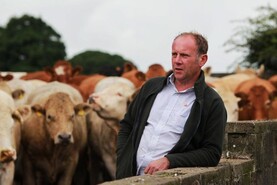The tractor sees me daily now compared to summer. Then it could be once a week or less that I graced its seat. I can see where Gerald Potterton gets some of his Farmer Writes ideas. Sitting on a tractor can give you plenty of time to think. It’s easy to get lost in a vast array of thoughts interspersed with dismounting the tractor to cut through plastic on another bale to keep the cows content. Through experience I’ve learned the hard way that too much thinking isn’t always pleasant.
A snapshot of recent thoughts include: how did the farm perform in 2016? What does 2017 have in store? Is the use of the word sustainability sustainable?
Weather
The weather in 2016 would have you driven demented, if you let it, with the cold, late spring and dampness throughout summer and early autumn.
Grass growth wasn’t an issue once that cold spell broke in May, but grazing it properly proved a challenge until early October. At least the autumn rotation plan went well. Ration use was back by about 8t on 2015, but reseeding balanced out much of the savings. There was a few extra acres done and we experimented with stitching in some seed to see if it has a place in future reseeding plans. It has. I’ll probably look to get a seed mix made up with a little bit more clover in it for 2017. This should allow for further reduction of artificial nitrogen.
More tactical use of slurry, high clover content and regular soil sampling have played a big part in reducing our artificial fertiliser use. Usage has dropped from 26t in 2012 to 11.75t in 2016.
Calving was eye-opening with a noticeable weight difference between natural and AI sired calves. Thankfully we recorded a first ever 0% mortality rate. Output has risen, with 96% of the cows calved having a sale. This would be over a sale per cow calved but one of the last heifers to be slaughtered had lesions so we are temporarily locked up. All that can be done is sit and wait for the results.
This resulted in holding off the sale of a few replacement heifers. Grass forms the backbone of the operation. Ninety percent of what is fed to stock is grown on the farm with straw and ration used to make up the balance. The finishing enterprise soaks up almost all of the ration, with well short of two tonne used for young heifers in their first winter and 71kg fed to the suckler herd in 2016. There’s serious power in grass if more realised it.
Looking ahead
For 2017, I envisage the “would you not convert to dairy?” question making a return after an 18 month sabbatical. From a long way out the year has been predicted as being tough on the beef front .
The rise in numbers has been predicted for a while and the figures are available to all so that will hardly catch farmers unawares.
We’re back to depending on live exports of cattle to countries in the Mediterranean, which don’t exactly have stable governments. A throwback to the 1980s.
The reactions to this challenge will be interesting. Will farmers plough on regardless, will they re-evaluate what they are doing or will they depend on politics to sort it short term?
I recall being in a similar position in 2014. A tough year but one that had a big impact on what happens on this farm. Clear decisions were made on the future direction of the business and those have paid off.






 This is a subscriber-only article
This is a subscriber-only article










SHARING OPTIONS: